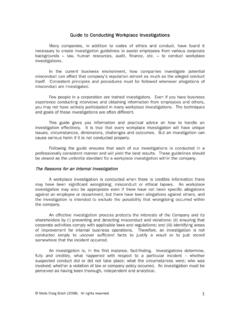Transcription of Practical Strategies for Feeding Aversions in Children ...
1 A special creation for you from the team of Speech and Occupational Therapists at All About Speech & LanguagePractical Strategiesfor Feeding Aversions in Children with Autismexperience. As a busy parent juggling many different roles and responsibilities, we hope that this resource helps to equip you with more manageable steps and at-home Strategies for expanding your child s food inventory and breaking the cycle of Feeding of Feeding :There are a variety of motor, cognitive, and speech and language milestones that go hand-in-hand with Feeding development. While these will not be outlined specifically, if you do have concerns about your child s general development, please seek further assistance from your child s physician who may provide a needed referral to an Occupational and/or Speech-Language Therapist. Assessments in these areas, and referrals made to other medical professionals ( nutritionist, or ABA therapist for behavioral Feeding support), can assist your child across his/her development in order to make sure he is growing and achieving the appropriate developmental milestones!
2 It is important to understand the various components of Feeding in order to identify any stages your child may be having trouble with that could be affecting their appropriate intake of food. These elements include:oral-motor ComponEnts of Feeding :The lips, jaw, teeth, tongue, along with certain reflexes, sucking/clearing, and swallowing are all vital parts of your child s ability to sustain proper of swallowing: There are 4 stages of swallowing which are important for successful Feeding , in which a child, or adult, may have impairment. Again, if Feeding difficulties are suspected, please seek assessment from an appropriate medical dEvElopmEnt: Just like all areas of development, from infancy through childhood, Children grow in their ability to eat a variety of foods and drink liquids. In early stages of toddlerhood it is quite common for Children to demonstrate strong preferences and dislikes for certain tastes and textures. By two years old, toddlers are typically able to tolerate all food textures (chewy, crunchy, soft, pureed), and eat foods from all food groups.
3 During this time, Children should also be demonstrating the ability to use a spoon and fork, drink from a regular cup, and finger feed themselves independently. If a child over the age of 2 years old is not meeting these milestones, he/she may benefit from occupational therapy evaluation to identify underlying of a possiblE Feeding /swallowing disordEr:Presented below are some signs that your child may be struggling with specific Feeding related issues. If you have these concerns, it is important to get your child assessed by the appropriate medical professional ( a Speech-Language Pathologist who specializes in swallowing/ Feeding ). This will confirm or rule out if there is an impairment contributing to the Feeding issues as a whole or if the difficulty is more sensory or behavioral in nature (best addressed by an occupational therapist or ABA therapist, respectively). There could be a larger problem at hand that may best be addressed by a trained professional, who can then guide you in the best plan for management.
4 Some of the more critical signs and symptoms to take note of include: Refusing to eat ( in general or certain foods/textures), spitting out food, or taking a long time to eat a small amount of food (typical meals should take no more than 15-20 minutes) Frequent coughing, throat clearing, gagging, and/or choking while eating Excessive drooling Pocketing food in the cheeks Trouble to coordinate chewing and swallowing resulting in food leaking from the mouth Vomiting and/or spitting up large amounts after eating An overall wet sounding voice or cry after eating Concerns with meeting appropriate rate of growth (height to weight comparisons given a child s age) Your child may demonstrate a motor-planning deficit which can add to mealtime frustrations if coordinating chewing and swallowing is a struggle or understanding how to make their hands work for scooping food and Feeding adults and Children alikE, mEaltimEs arE known to providE riCh sEnsory ExpEriEnCEs, full of various smElls, sounds, tastEs, tEmpEraturEs, tExturEs, and intEraCtions with othErs.
5 Mealtimes can be very pleasant and fun experiences when sensory processing is going well. However, for many of our Children with Autism, significant sensory challenges are often experienced including heightened sensitivities or sensory overload which turn mealtimes into very stressful experiences. Furthermore, difficulties with communication (verbal and nonverbal) and focus of attention pose additional challenges for a child with Autism and their parent at mealtime. As a way of coping with the sensory and communication stresses associated with mealtimes, often our Children with Autism develop Strategies that may include trying to limit sensory input or withdrawing from the social and communicative demands of the meal by: being overly selective in their selection of foods/textures, becoming inflexible or trying to control the mealtime routine, refusing to eat or eating limited amounts so as to reduce the number of transitions with which they must cope, escaping the situation, covering ears or closing eyes, or repetitive/stereotypic behaviors to help manage this perceived chaos.
6 It is no wonder that this mealtime stress and inflexibility causes concern for parents who are working hard to ensure their child has a well-balanced and nutritional diet. Forcing your child to suddenly change his eating patterns or to eat specific foods doesn t help him to learn to eat and enjoy meals but rather creates added stress to an already stressful 1. pairing prEfErrEd and non-prEfErrEd foods with a tokEn systEm: Positive reinforcement can be incredibly powerful in helping to reduce negative behaviors associated with mealtimes. When using positive reinforcement, it is key to praise positive behaviors and ignore negative behaviors. Positive reinforcement may include verbal praises, clapping, continued interaction with you, and/or immediately receiving a preferred item or other motivating tangible when a child completes what is desired. This focus on acknowledging and reinforcing only the desired behavior will slowly begin to extinguish undesired behaviors and teach your child a new action or gEt startEd, sElECt a non-prEfErrEd food itEm that is developmentally appropriate and similar to a food already in your child s inventory.
7 This will be your introductory your Child attEmpts or ComplEtEs a dEsirEd bEhavior with this non-preferred food item (see list of possible behaviors under Desensitization section, with the goal of working toward eating the item), immediately reward their attempt with a preferred food. Over time, this pairing of non-preferred foods immediately followed by a preferred reinforcer will lead to increased acceptance of the non-preferred rEinforCEmEnt may also inCludE using this tokEn systEm paired with a visual behavior chart, which can help your child see and work toward a goal. For example, after each successful pair of accepting the non-preferred and receiving the preferred items, he may earn one smiley face or sticker on a visual behavior chart of 3 boxes. After 3 successful trials or pairs are completed, and 3 smiley faces earned on his behavior chart, he may 3 Strategies for At-Home Support:When using positive reinforcement, it is key to praise positive behaviors and ignore negative behaviors.
8 Earn an even larger reinforcer such as playing with a preferred toy. Alternate these cycles of pairings, gradually increasing the number of target attempts and fading the reinforcement schedule ( the child may now be expected to take 2 separate bites, then work up toward 3 separate bites before a reinforcer is provided. Or, perhaps you may increase the number of overall trials to be completed on the behavior chart before a final motivating reward is provided).pairing a prEfErrEd food or drink in bEtwEEn tastEs of a new or non-preferred food item may help to reduce the aftertaste that many problem eaters find to be aversive. Overtime, less bites or sips of the preferred item are provided as the new food item becomes , havE patiEnCE and don t givE up your Efforts; it may take on average at least 10 exposures to a new food paired with positive reinforcement before the child will accept the food on a consistent basis! Practical Strategies to try at-homE:After we rule-out or begin to manage any underlying difficulties or true impairments in the structures and Feeding process as a whole, then various Strategies can be used in the home with greater success to shape positive Feeding experiences and behaviors.
9 Described below are three Strategies that have proven to aid the introduction and acceptance of new foods. If your child is struggling during mealtime with his/her ability to tolerate new or varied foods, these Strategies would be beneficial for you to incorporate into your dEsEnsitizationDesensitization is the process by which Children are slowly and gradually introduced to new and/or non-preferred food items, with the goal of expanding the child s food repertoire through decreased defensiveness and increased tolerance. This progression takes place through repetition, rewards, and engagement. Follow the steps below to help desensitize your child to a new food:makE lists of thE foods and drinks your Child will tolEratE and foods you would like him/her to eat. You can organize foods by categories as well as by properties of the food ( texture, size, color etc.). Select a new food item to begin the desensitization process; an item that is closely related with slight variations will have the most success at first ( if your child already eats yogurt, consider pudding as a food to begin desensitizing to).
10 BEgin dEsEnsitizing to foods at timEs othEr than main mEaltimEs, for example during play, snack time, or within therapy sessions if your child receives support services. Perhaps you may play with toy food, feed it to dolls during pretend play, or cut out pictures of the food item from magazines. These fun experiences will help your child gradually view this item in a non-threatening way. if thE itEm is wrappEd in spECifiC paCkaging, work to have your child gradually grow comfortable looking at, touching, holding, or even just opening/unwrapping the item. Eventually, when working to have your child tolerate touching this new food, use cookie cutters to explore the new food item, count or sort the food, or finally use the item to paint or create art thE food itEm has bEComE inCrEasingly familiar and tolerated in play, start by simply having your child sit at the table with the food you would like him/her to eat, placed somewhere on the table.










